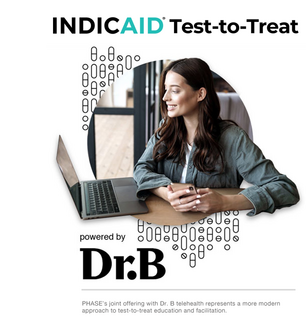The Diagnostic Partner: Addressing the Equity Implications of Health Diagnostics
InsightsFebruary 27, 2023

The intersection of healthcare diagnostics, and health equity as explored by Emory University’s new ADJUST Center.
Achieving health equity, in which everyone has a fair and just opportunity to attain their highest level of health, requires ongoing efforts to address historical and contemporary injustices, overcome barriers to healthcare access, and eliminate preventable health disparities. When it comes to diagnostics, the COVID-19 pandemic cast a harsh light on the disparities in how different U.S. population groups accessed tests. Driven by these disparities, Emory University is launching the Advancement of Diagnostics for a Just Society (ADJUST) Center.
 We recently spoke with Dr. Wilbur Lam, who will head up the ADJUST Center. Dr. Lam is a principal investigator at the Atlanta Center for Microsystems Engineered Point-of-Care Technologies (ACME-POCT), where he has been instrumental in testing the quality of COVID-19 diagnostics on behalf of the NIH’s Rapid Acceleration of Diagnostics (RADx) program through a collaborative initiative with Children’s Healthcare of Atlanta, Emory University, and Georgia Tech. He is also a pediatric hematologist/ oncologist at Children’s Healthcare of Atlanta’s Aflac Cancer and Blood Disorders Center, and an associate professor at Emory’s Department of Pediatrics and Georgia Tech’s Wallace H. Coulter Department of Biomedical Engineering.
We recently spoke with Dr. Wilbur Lam, who will head up the ADJUST Center. Dr. Lam is a principal investigator at the Atlanta Center for Microsystems Engineered Point-of-Care Technologies (ACME-POCT), where he has been instrumental in testing the quality of COVID-19 diagnostics on behalf of the NIH’s Rapid Acceleration of Diagnostics (RADx) program through a collaborative initiative with Children’s Healthcare of Atlanta, Emory University, and Georgia Tech. He is also a pediatric hematologist/ oncologist at Children’s Healthcare of Atlanta’s Aflac Cancer and Blood Disorders Center, and an associate professor at Emory’s Department of Pediatrics and Georgia Tech’s Wallace H. Coulter Department of Biomedical Engineering.
Why is Emory launching the ADJUST Center?
The COVID-19 pandemic was the catalyst. We asked ourselves, what have we learned from our work with COVID-19 diagnostics, and what should we do next? Because people were able to test themselves for COVID-19, the medical community, the scientific community, and the public have learned that decentralized diagnostics work. But shifting the diagnosis of disease to the home raises many questions. How does this affect the practice and business of medicine? Who controls the resulting data? Who will pay for these tests? Who sets policy?
The other driver is the lack of health equity in diagnostic technology. What we saw with the pandemic is that, as usual, people with resources had access to testing first. Immunocompromised and chronic illness patients – who were likely to be from communities of color, of lower socioeconomic status (SES), and far from healthcare resources geographically – needed testing most but didn’t have access. Black and Latinx communities were hit particularly hard by the pandemic; Centers for Disease Control (CDC) data shows that people in these groups who contracted COVID-19 were roughly three times more likely to die from it than non-Hispanic white people. Asian Americans and Native Americans were also at higher risk.
The ADJUST Center has two missions: to help move diagnostic technologies towards the patient and the patient's home, and to tackle the societal issues that hinder equity in diagnostics. We’ll tap resources across the Emory campus that can contribute to our mission – from the Goizueta Business School to the Rollins School of Public Health – as well as partner institutions like Georgia Tech and Children's Healthcare Atlanta. Atlanta’s Grady Hospital is also part of our center and as such represents underserved populations whom we’ll focus on helping. We’ll also be developing technologies and helping technology developers to ensure that new solutions are designed to be accessible for underserved populations.
How can diagnostics impact health equity?
 You can't just create a technology and expect it to be utilized by everyone in the same way. Healthcare is not one-size-fits-all; it has to be contextualized within communities and cultures. For example, telemedicine was meant to democratize healthcare. Of course, it grew by huge numbers during the pandemic, but not for those of low SES. Pre-COVID, studies showed that low SES communities had the highest adoption of telemedicine when it was offered in churches, because that was a trusted place for the people who lived there. Community centers like churches had the infrastructure which allowed people to access healthcare remotely even if they didn’t have the technical capabilities at home. Then those centers closed down during the pandemic and many didn’t reopen or opened with reduced capacity. The digital divide and issues of trust are both major factors, and those cultural insights need to be part of the plan.
You can't just create a technology and expect it to be utilized by everyone in the same way. Healthcare is not one-size-fits-all; it has to be contextualized within communities and cultures. For example, telemedicine was meant to democratize healthcare. Of course, it grew by huge numbers during the pandemic, but not for those of low SES. Pre-COVID, studies showed that low SES communities had the highest adoption of telemedicine when it was offered in churches, because that was a trusted place for the people who lived there. Community centers like churches had the infrastructure which allowed people to access healthcare remotely even if they didn’t have the technical capabilities at home. Then those centers closed down during the pandemic and many didn’t reopen or opened with reduced capacity. The digital divide and issues of trust are both major factors, and those cultural insights need to be part of the plan.
Another significant issue is usability. In our ACME-POCT work with COVID-19 tests, the majority of those tests submitted for review actually failed, not because of technical issues with the tests, but because patients couldn’t use them. If a person in their home has to go through many complicated steps, or can’t see well enough to read the directions, or aren’t dexterous enough to use a pipette, they can’t successfully complete the test. It doesn’t matter how well a technology works; if the user can’t effectively implement the technology, it’s useless.
If we want to offer all people the same access to diagnostic testing, we have to understand each community, engage with them, and bring them the technology in a way that works for them.
What kind of projects will ADJUST pursue?
Our human factors group is already working hand in hand with the NIH to make rapid COVID-19 tests more accessible for people with disabilities. For example, blind people have not been able to use rapid tests because they can't see the results. What happens when you link the test to a device that can provide an audio readout? Technology that matters moves healthcare into the community and works with people rather than shutting them out.
Another project concerns the human papillomavirus virus (HPV) which can cause cervical cancer. Technology exists for self-diagnosis, but it hasn’t been deployed. We’re exploring why, including issues of cost and usability, and looking for home test solutions that provide good data, will be trusted by the patient, and can be produced in a financially sustainable manner.
What will success look like?
Within five years, we will be able to say that we’ve impacted underserved patients by providing access to diagnostic technologies across Georgia and hopefully beyond. And then within 10 years, I'd love to see the new products that we’ve created or inspired available in the marketplace. We also plan to disseminate all our knowledge for the use and benefit of others.
At the ADJUST Center, we’re going to look at how can we better serve communities of color, lower income groups, and those not in easy geographic reach of healthcare resources with usable testing that can be successfully and fairly deployed. I’m excited to get started.



